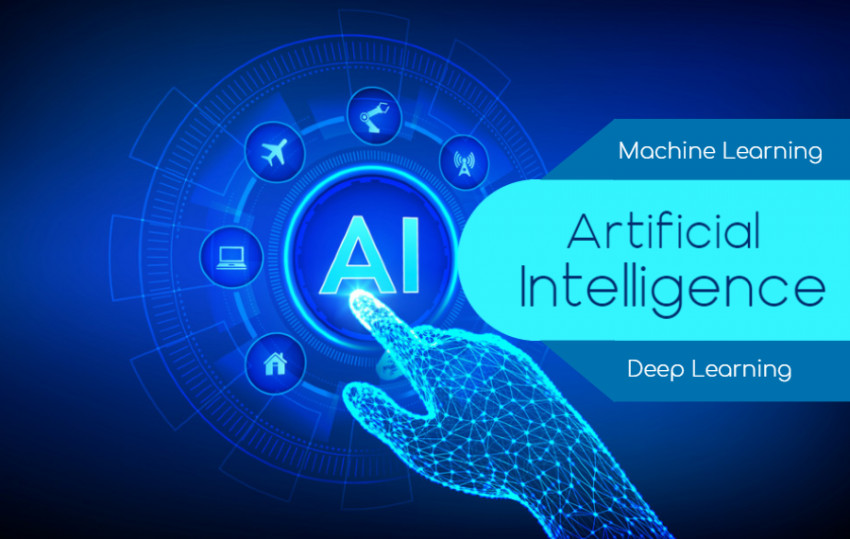
Nowadays you must have heard and used about new innovative technology around you like driverless cars, voice-operated Alexa, voice-operated smartphones, etc.
Have you thought about how suddenly all this change has come about in human society? What used to be done in minutes is now being done in seconds. All this is possible due to Artificial Intelligence (AI) which is being done using machine learning and deep learning. Let us see in detail what is the difference between Artificial Intelligence, Machine Learning, and Deep Learning.
What is Artificial Intelligence?
AI is the abbreviation for artificial intelligence. AI refers to the ability of machines to learn and act on their own, without being guided by a human.
In the near future, AI will play a central role in all aspects of our lives. From providing personal assistant services to managing our finances, AI is already making a big impact.
- Types of Artificial Intelligence -
Generally, artificial intelligence (AI) systems can be divided into two categories –- Autonomous agents - Autonomous agents are self-healing machines capable of learning from their experiences.
- Intelligent systems - Intelligent systems are machines that are controlled by someone else and are capable of exhibiting human or even superhuman performance.
- Pre-requisite for using artificial intelligence -
There are several requirements that must be met for AI to be effective, namely:- Artificial intelligence must be able to understand natural language.
- Must be able to detect patterns and correlations in data.
- They must be able to learn from experience and evolve over time.
- Using Artificial Intelligence in different ways -
There are different ways in which Artificial Intelligence is used, including:- Involving machines in tasks that are traditionally done by humans such as data entry or financial analysis
- Making decisions for businesses on their behalf
- Helping people with tasks that are difficult or time-consuming, like translating text or making a decision based on complex data.
- Benefits of Artificial Intelligence –
- AI can have a number of benefits for businesses. For example, it could help reduce labor costs, speed up decision-making, and improve customer service.
- AI is becoming an important tool for improving society as crime free. For example, it could be used to develop smarter algorithms that can identify patterns in data, or help reduce crime.
- AI can be used to create better products. For example, a machine learning algorithm could be used to identify which products are most popular and make them more affordable.
- AI can be used to improve learning by helping students learn at their own pace and in a way that is compatible with their individual needs.
- AI can be used to create better products than ever before. For example, a machine learning algorithm could be used to identify which items are bestsellers and develop new versions of those products that are more affordable or popular.
- AI can help manufacturers design more sustainable products that last longer and meet consumer demand for greater convenience and innovation.
- AI can be used to help save the environment. For example, a machine learning algorithm could be used to identify which items are causing the most pollution and develop new products or services that reduce that pollution.
What is Machine learning?
Machine learning is a process of transforming data into insights in order to understand patterns for taking decisions and predictions about future events efficiently and quickly. This process is called the algorithm of Machine learning.
Machine learning-based applications are developed by using Python programming language. Python is the most popular and powerful programming language which is used for machine learning, data science, and scientific application programming.
Machine learning is a powerful technology that can be used to improve business processes and outcomes which finally helps to save time and money.
- Working principle for Machine Learning -
Machine learning works on the basis of models. Machine learning models can be divided into two types:
Supervised – it is designed to learn from examples and predict future events.
Unsupervised - it is designed to learn without any guidance
Machine learning is known as the application of Artificial Intelligence, in other words, we can say that it is a process of applying artificial intelligence (AI) to data in order to make better decisions. This can be done in a number of ways, including through predictive modeling, natural language processing (NLP), and machine learning algorithms.
Predictive modeling is the most common way that machine learning is used for business purposes. It uses AI to predict future events and then uses this information to help make better business decisions.
Natural language processing (NLP) is another popular way that machine learning is used for business purposes. NLP helps you understand human communication by understanding the words that people use when they talk about their experiences or problems. This information can then be used to help improve your customer service experience or make smarter decisions about products or services.
- Common uses of Machine Learning -
Machine learning is commonly used in business to identify trends and correlations in data, predict outcomes based on past events, assemble facts and figures to form a narrative, or assess customer needs.
The most common applications of machine learning in business include fraud detection and prediction, supply chain management, customer service and identifying feedback, predicting customer behavior, even understanding complex financial models, and marketing research.
What is deep learning?
Deep learning is a type of machine learning that uses the processing power of computers to learn how to make decisions on its own. It has the power to revolutionize business usage and processing. It can be used to process large amounts of data, which makes it an ideal tool for business processes.
Deep learning can be used to improve decision-making in a number of ways, including recognizing patterns in data, classifying objects, and extracting insights from data. It’s also been used to create smart machines like driverless vehicles, etc. that are able to understand complex systems better.
- Benefits of deep learning -
The benefits of deep learning include increased accuracy and efficiency when it comes to business processes, as well as decreased effort and time spent on tasks.
In addition, deep learning can help you learn more about your customers and potential customers, which can lead to better customer retention and conversion rates. - Uses of deep learning -
Following is the scope of application in which we use Deep Learning –- Understanding human behavior
- Determining the company's earnings valuation for overvalued or undervalued
- Finding new sources of income
- Building models that predict the outcomes of future events
- Practical uses of deep learning -
Always remember one thing, every experimental example of deep learning will also be part of artificial intelligence (AI) and machine learning.
One of the most common applications of deep learning is machine translation, which allows machines to read and understand the text more accurately than human beings ever could. This technology has been used in many different fields, from medical diagnostics to legal writing.
Deep learning can also be used in business to help managers make faster and better decisions. For example, by understanding how customers are influenced when they shop online or in-store, businesses can save time and money by using deep learning algorithms to make faster decisions.
Another best and most common example of deep learning is driverless automated vehicles. The vehicle's algorithm works according to the pattern of traffic and local environmental data. It identifies patterns in the collected traffic data and then acts and makes decisions to drive the vehicle accordingly.


